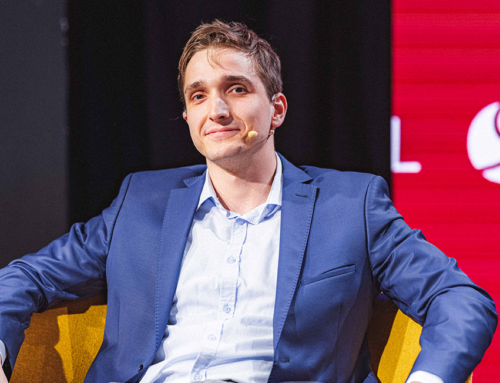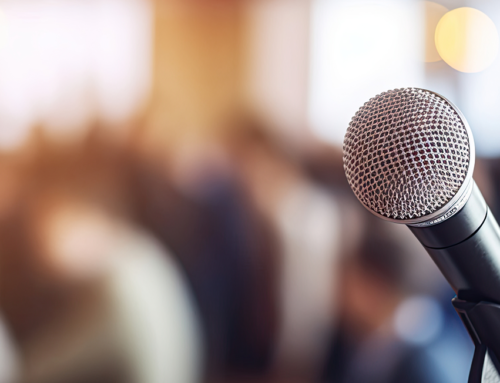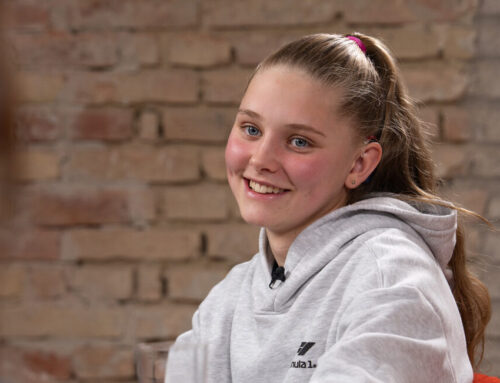A brainstem implant can restore hearing after acoustic neuroma
A rare disease called neurofibromatosis can cause benign nerve tumors that can also affect hearing. Today, Elena-Daniela Nistor can hear again thanks to a brainstem implant: “I know how hard it was for me to find the right information and I would like to change that.”

2015 wasn’t a good year for Elena-Daniela Nistor from Galați, Romania. “At the time, I was doing eye tests and my doctor noticed something different on the occult nerve. That´s why I did an MRI and I found out I have type 2 neurofibromatosis”. This discovery gradually impacted the world of this at the time 32-year-old woman.
Neurofibromatosis (or NF) is a genetic mutation which is inherited in almost half of all cases. In the other half, this change is “acquired” or, in other words, it happens spontaneously. The chromosome responsible for this change mutated during embryonic development. In the case of the acquired genetic mutation, not all cells in the body may be affected. This means that the cells in the other parts of the body might stay unchanged.
First described in 1882 by the German physician Friedrich Daniel von Recklinghausen, neurofibromatosis belongs to the group of the so-called rare diseases. Rare diseases are either life-threatening or chronic diseases that affect up to 5 in 10,000 people. Three different types of neurofibromatosis are known today: NF1, NF2 and schwannomatosis. In each of these diseases, a different gene is affected. All three types of NF have a common tendency to form tumors in the nervous system.
Neurofibromatosis can change life
The most common form of NF is NF1 or Morbus Recklinghaussen, which affects one in about three thousand people. Typical initial symptoms are pigment spots on the skin, called ‘café au lait’ spots, or freckles in the armpit or groin area. NF1 can cause many problems, such as tumors in the entire nervous system – from the optic nerve to the spinal cord and to spinal curvatures. Other problems include short stature, hypertension, cognitive and psychosocial problems, as well as chronic pain. On the other hand, NF3 or schwannomatosis is limited to the formation of benign tumors; however, these can also often cause great pain and lead to further problems.
NF2 or central neurofibromatosis forms tumors on the central nerve structures. For example, opacification of the lens, a special form of cataract, often impairs the eyesight of the affected patient. Pigment spots are also common, along with accompanying symptoms such as headaches or nausea.
However, the focus in NF2 patients is on benign tumors on the eighth cranial nerve, which is essential for hearing ability and balance. These tumors are called vestibular schwannomas or acoustic neuromas. They occur frequently on both ears.
“I didn´t have any tears!”
“I started to lose my hearing in 2007 – or at least that´s when I started to notice it myself. I was also dizzy and tired. But I blamed it on the stress.” Elena-Daniela Nistor works in the marketing team of a travel agency, so things can get stressful at times. Gradually, her hearing deteriorated. But it wasn’t until eight years later, when her ophthalmologist noticed a peculiar change in her eye and ordered a magnetic resonance imaging scan, that led to the diagnosis of type 2 neurofibrom atosis.
atosis.
“I had a difficult surgery.” A neurinoma on the right auditory nerve was removed. Still, it had already grown so much around the nerve that it was no longer functional. “I could not hear on the right side, I didn´t have a good balance, I even had no tears, nasal secretion or saliva.”
Over the next two years, she has also lost her hearing on the left side, which led to complete deafness. “I can say that NF2 taught me to lead a completely different life. I learned to work based on sight, not hearing. I learned to read lips.” It was a challenge not only for her, but also for those around her, especially for her family.
Benign does not always mean harmless
When it comes to benign tumors of the auditory nerve, it is sometimes enough just to observe them. But when a neurinoma exerts pressure on the nerve or grows around the nerve, it can cause various complications. This was also Elena Nistor´s case: she had ringing in the ears, balance problems and hearing loss. It is also possible to get the paralysis of the facial nerve with impairment of the mimic muscles.
Prof. Dr. Christoph Arnoldner, Deputy Head of the ENT University Clinic Vienna and Head of the Inner Ear Research Laboratory, is a specialist in this field. He considers NF2 to be the cause of hearing problems in those cases when speech comprehension is more impaired than sound perception. The tumor is usually removed surgically. He says that this is often a challenge, because if an injury occurs, facial expressions can be permanently affected in addition to hearing and balance problems. Therefore, he emphasizes the importance of early diagnosis and intervention: “then we often manage to save the nerve”.
The sense of hearing can be recovered!
Even if the tumor can be removed without damaging the nerve, hearing loss is often inevitable. ENT specialist Prof. Arnolder explains: “Tumors are now thought to release proteins and other substances and damage the cochlea in this way.” The sense of hearing is the first, and so far, the only human sense organ that can be artificially replicated and replaced. In Romania, cochlear implants have been available for adults suffering from hearing loss since 2000. For several years now, they have been used even when the deafness affects only one side, and the affected person can still hear on the other ear. Since NF2 patients are more likely to develop a neurinoma on the other side, cochlear implants are strongly recommended even in cases of unilateral hearing loss.
However, a precondition for this is the normal function of the auditory nerve. If this is not the case due to a tumor or surgery, as in the case of Elena-Daniela Nistor, there is an option of an auditory brainstem implant (ABI). The audio processor and implant are similar to a conventional cochlear implant, but a flat electrode is placed on the brainstem and stimulates the auditory region there.
In Romania, this implantation surgery was not performed. But Elena-Daniela Nistor, born in Transylvania, was not about to give up so quickly. “I read a lot on the internet, I read a lot of articles – especially information in English. And I sent a lot of emails to different clinics.” Finally, she came across Casa di Cura in Piacenza, Italy. “They were very understanding” she says. In April 2019, a medical team there implanted her with ABI. The team was led by Prof. Mario Sanna, M.D., and Abdelkader Taibah, M.D., who are both experts in otology, neurotology, and skull base surgery at Casa di Cura.
“I am so glad to hear again!”
“That period was quite difficult for me”, Elena-Daniela Nistor describes the time after receiving the diagnosis. “But now I am extremely happy to hear! Since I was deaf for two years, I am able to compare the “two” lives now.”
“Based on what I have read and experienced so far, I use this implant in parallel with lip reading.” In cochlear implants, pitch is encoded by the location of stimulation in the cochlea. However, the pitch is different with the ABI. Therefore, the hearing rehabilitation process and adjustment to the implant are more complex. The hearing results usually remain somewhat behind those with a cochlear implant, but they are still a great relief in everyday life.
“At the activation I did not recognize any sound.” For two years, Elena Nistor actively practiced listening with ABI. “I started with one session a week and then I went more often, twice a week. And at home, my friends or parents helped me with additional exercises.” She learned to recognize sounds, then to understand individual syllables or numbers, and finally to understand whole words or sentences. Today, the implant is her ticket to the world of hearing and a good help in everyday communication.
“People should know that there are solutions!”
Recently, the Corona pandemic made traveling to Italy difficult. “I was happy to discover that there are experts in Romania as well.” Dr. ing. Antonius Nicolae Stanciu, with his company Eurolegal, which is one of the two official partners of the implant manufacturer MED-EL in Romania, has taken care of the ABI user ever since. ” I can ask more questions here and get an explanation for my hearing easily,” she says happily. “He speaks to me in Romanian. And additionally, I’m not so tired from the road.”
„I am very grateful to the medical team in Italy, without which I would not hear now. I am also grateful to my speech therapist Viorel Pirlea: he taught me to understand the sounds again and advised me in all aspects of life” the happy ABI user says. “Now, I just want to keep my health the way it is now – or improve it” she says, adding: “I know that there are other people who need this type of implant. I really want people with these needs to know that there are solutions!”






